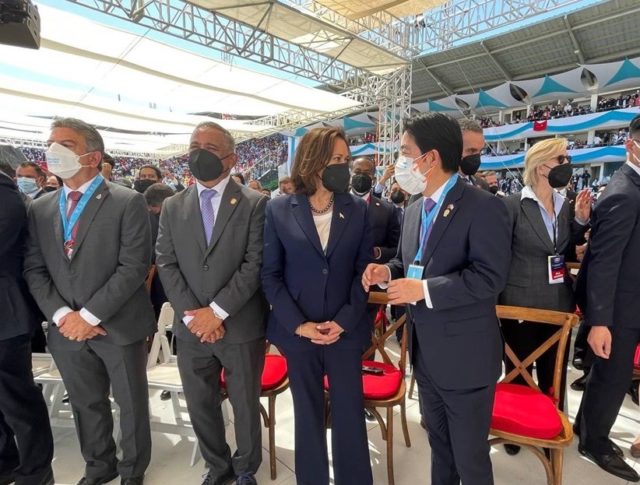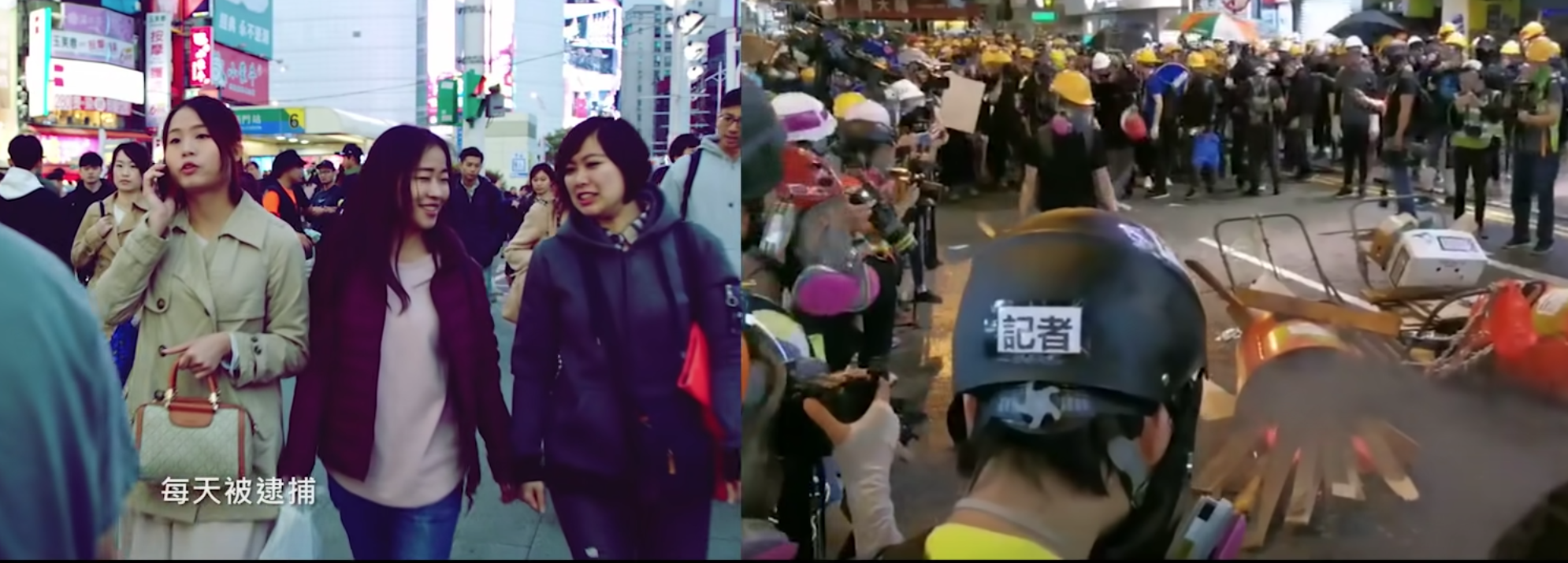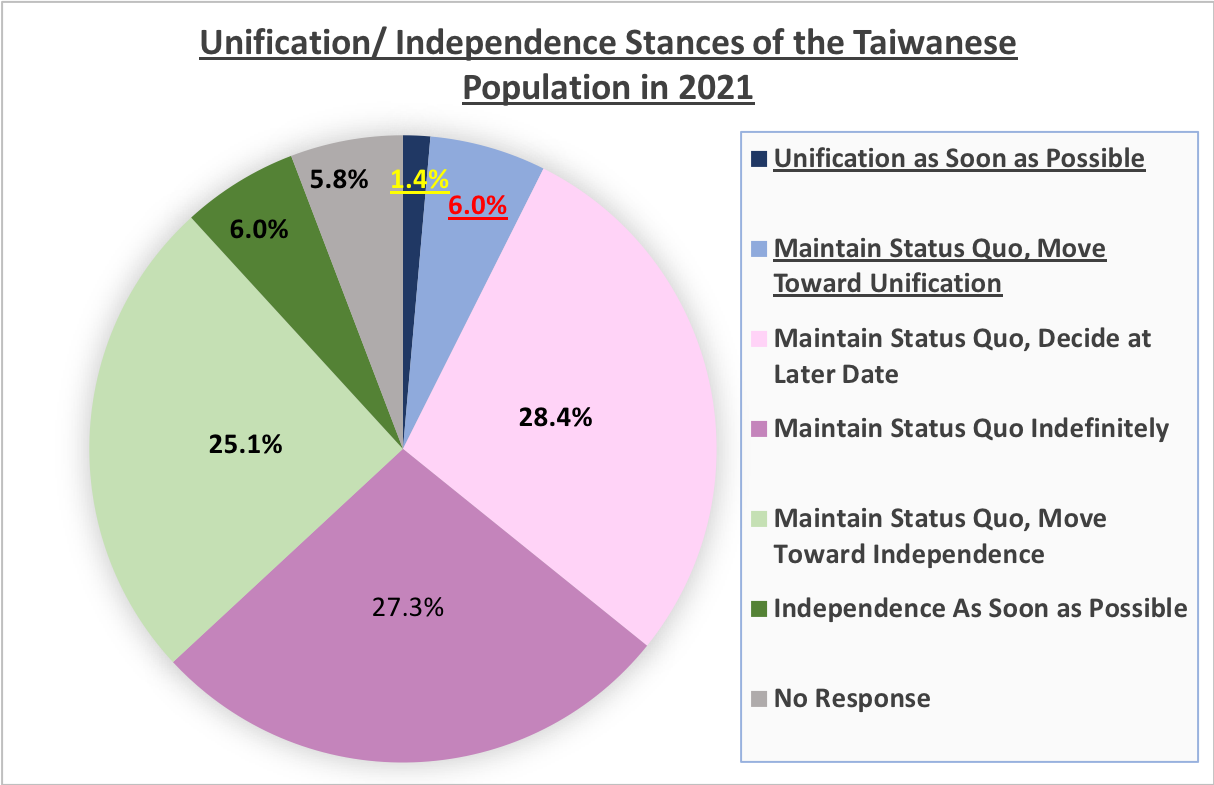
All Necessary Measures: China’s Shifting Approach to U.S.-Taiwan Relations
Publication: China Brief Volume: 22 Issue: 3
By:

Last month, U.S. Vice President Kamala Harris spoke briefly with Taiwanese Vice President Lai Ching-te at the inauguration of President Xiaomara Castro in Honduras (Taiwan News, January 28). When asked about the public interaction between Harris and Lai, People’s Republic of China (PRC) Ministry of Foreign Affairs (MFA) spokesperson Zhao Lijian responded curtly that “there is no Taiwanese ‘vice president’ since Taiwan is a province of China.” Zhao called on the U.S. to “abide by the one-China principle and stipulations in the three China-U.S. joint communiques, take China’s position and concerns seriously, stop all forms of official interactions with Taiwan and avoid sending wrong signals to ‘Taiwan independence’ forces” (FMPRC, January 28). Despite Zhao’s rejoinder, China’s response was subdued. Beijing’s reactions to other recent engagements between top U.S. and Taiwanese officials have typically been more bark than bite. For example, neither then President-elect Donald Trump’s congratulatory phone call with Taiwanese President Tsai Ing-wen in December 2016, nor U.S. Health and Human Services Secretary Alex Azar’s Taiwan visit to Taiwan in August 2020, evoked the kind of furious reactions from Beijing that many in Washington predicted. Although China is currently much stronger than in the mid-1990s, at that time, lesser levels of U.S.-Taiwan interaction sparked far sharper reactions from Beijing. Following President Lee Teng Hui’s visit to his alma mater- Cornell, the People’s Liberation Army (PLA) conducted large-scale, live-fire exercises that precipitated the 1995-1996 Taiwan Straits crisis. Changes in how Beijing responds to official U.S.-Taiwan engagement underscores China’s expanding and evolving use of the military instrument in the Taiwan Straits, which now goes beyond reactively imposing costs on Washington and Taipei for perceived transgressions of the One China Principle. China’s burgeoning military power still serves this purpose, but coupled with other instruments of national power, is now developing into a means to deter U.S. intervention and proactively compel Taiwan’s unification with the PRC.
Over the past several years, China has applied sustained military pressure on Taiwan, with the PLA regularly flying warplanes into Taiwan’s Air Defense Identification Zone (ADIZ), and conducting joint exercises and naval patrols in the island’s vicinity. China’s ADIZ sorties have continued largely independent of fluctuations in international politics. For example, during the first week of the Beijing Olympics, which President Xi Jinping has called an inspiration for global peace and solidarity, the PLA Air Force (PLAAF) conducted five incursions into Taiwan’s ADIZ (ROC MND, February 10; FMPRC, February 5). In October, despite no immediate provocations by either Taipei or Washington, the PLAAF undertook a series of mass ADIZ incursions with the largest probe involving over 50 warplanes (Focus Taiwan, October 4). In response to U.S. concerns over this aerial intimidation of Taiwan, MFA spokesperson Hua Chunying cited the actions as legitimate countermeasures to intensifying U.S.-Taiwan security cooperation, and called on Washington to “stop supporting and emboldening separatist forces” (FMRPC, October 4). Over the past several years, the Taiwan Affairs Office of the State Council has repeatedly averred that the PLA’s actions are necessary to defend China’s national sovereignty, and deter the Democratic People’s Party (DPP) from “secessionist” efforts to “achieve Taiwanese independence in collusion with external forces” (i.e., the U.S.) (Xinhua, April 14, 2021; China Daily, September 16, 2020)
Communiques that Bind?
For four decades, the Three Communiques issued in 1972, 1979 and 1982 have provided a framework for sustaining U.S.-China relations despite irreconcilable differences over Taiwan. The authors of the initial 1972 Communique worked around the “Taiwan problem” by crafting the document as a series of parallel statements. The Chinese position was that the PRC is “the sole legal government of China; Taiwan is a province of China which has long been returned to the motherland; the liberation of Taiwan is China’s internal affair in which no other country has the right to interfere; and all U.S. forces and military installations must be withdrawn from Taiwan.” The U.S. position was more ambivalent, acknowledging “that all Chinese on either side of the Taiwan Strait maintain there is but one China and that Taiwan is a part of China”, and reaffirming its commitment to a peaceful settlement of Taiwan’s status (U.S. State Department).
In the 1979 Communique, which coincided with the normalization of U.S.-PRC relations and derecognition of the Republic of China (ROC), the U.S. recognized the PRC as the “sole legal government of China”, but also stipulated that the American people “will maintain cultural, commercial, and other unofficial relations with the people of Taiwan” (AIT). Concurrently, the National People’s Congress Standing Committee issued its “Message to Compatriots in Taiwan”, which pledged to seek the “peaceful reunification of the motherland”, a commitment later reaffirmed by Beijing in the 1982 U.S.-China joint communique (CGTN, January 1, 2019; AIT). In order to achieve normalization and deepen cooperation on matters of shared interest (developing economic relations and strategic collaboration against the Soviet Union), the U.S. endorsed China’s proscription against “two Chinas”, which thrust Taiwan into an ambiguous international position. In order to preserve what it viewed as an important strategic and normative relationship with Taiwan, Congress passed the Taiwan Relations Act (TRA). The TRA threaded the needle by making it U.S. policy to maintain a robust “unofficial” relationship with Taiwan, thereby casting the ROC a lifeline without contravening the U.S.’s One China policy (U.S. Congress).
Beijing and Washington continue to cite the Three Communiques as foundational to bilateral relations, but four decades removed from the final communique, the situation is greatly changed. In the 1970s and early 1980s, Washington and Beijing effectively imposed a new framework on Taiwan. Now, China is seeking to remake the current paradigm, while the U.S. and Taiwan strive to preserve the status quo. As a result, the role of the Three Communiques in U.S.-China relations has shifted from a roadmap to address bilateral differences to a set of guardrails for both sides vis-à-vis Taiwan. The commitments made therein provide limited assurances to Washington that Beijing will desist from using force, and to China that the U.S. will not support Taiwanese independence. For example, in his November 16 call with President Biden, Xi cited U.S. recognition of Taiwan as a part of China in the Three Communiques, and called on the U.S. to change course to win the trust of the Chinese people (FMPRC, November 16, 2021). While China has urged the U.S. to uphold the commitments It has made through the Three Communiques, Beijing has simultaneously hedged against its own pledge to pursue peaceful reunification by developing and deploying a range of military and other coercive instruments to compel Taiwan’s unification with the PRC (China Brief, November 5, 2021). Under Xi, China has intensified these efforts as hopes for unification through non-military, political means fade.

(Screenshot of 2020 Taiwan presidential election campaign ad for Tsai Ing-wen and the DPP juxtaposing images of ordinary life in Taiwan with police brutality in Hong Kong, source: Youtube)
One Country, One System
Xi has established Taiwan’s unification with the PRC as central to achieving China’s long-sought goal of national rejuvenation (China Leadership Monitor, December 1, 2021). In his October address on the 100th anniversary of China’s 1911 Nanchang uprising, Xi called “Taiwan independence secessionists” (“台独”分裂, Taidu Fenlie) the greatest obstacle to the unity of the motherland and a “severe hidden danger to national rejuvenation.”( 民族复兴的严重隐患, Minzhu fuxing de yanzhong yunhuang). (Gov.cn, October 9, 2021) The PRC’s preferred policy option for Taiwan is “peaceful reunification,” but if this route proves infeasible, Beijing reserves the right to resolve the situation by force. In his January 2019 speech on the 40th anniversary of the PRC’s Message to Compatriots in Taiwan, Xi stated: “We Chinese should not fight each other. We will work with the greatest sincerity and exert utmost efforts to achieve peaceful reunification, because this works best for the people on both sides and for our whole nation.” However, Xi then stated that “we do not renounce the use of force and reserve the option of taking all necessary measures” (State Council Taiwan Affairs Office, April 12, 2019). In the speech, Xi also cited the “One Country, Two Systems” framework, under which Hong Kong retroceded to China, as the optimal path for Taiwan’s unification with the PRC. Xi explicitly linked peaceful reunification and “One Country, Two Systems” with the 1992 consensus, which is the platform of Taiwan’s more-pro China party, the Kuomintang (KMT), for cross-straits relations. A year ahead of Taiwan’s Presidential elections, Xi’s remarks were politically ill-timed and along with the subsequent 2019-2020 Hong Kong protests and crackdown, severely damaged the KMT’s electoral prospects.
In March 2019, Kaoshiung Mayor and future 2020 KMT Presidential candidate Han Kuo-yu visited Hong Kong, Macau and Shenzhen (South China Morning Post, March 25, 2019). In Hong Kong, he met with Chief Executive Carrie Lam and made an unannounced visit to the Chinese government’s liaison office. Photos of Han leaving the PRC office caused a furor on Taiwanese social media, and his visit was criticized for jeopardizing national security and self-determination (New Bloom, March 23, 2019). Shortly thereafter, mass protests erupted in Hong Kong against China’s imposition of a new extradition bill and the city’s decreasing political autonomy. Despite early struggles, the Tsai campaign capitalized on China’s harsh Hong Kong crackdown, which fostered a growing perception among Taiwanese voters that “One Country, Two Systems” is a Trojan Horse for conquest by China. A viral ad for Tsai juxtaposed pictures of young people in Taiwan peacefully enjoying life with images of police brutality in Hong Kong. The narrator notes that ordinary Taiwanese once took the tranquility of daily life for granted, but that “every day, only a few hundred kilometers away, countless young people are arrested, imprisoned, abused, and made to ‘disappear.’” The ad uses Xi’s invocation of the 1992 consensus against the KMT, casting the formula as a recipe for the destruction of Taiwanese democracy : “It turns out the ‘1992 consensus’ is ‘One Country Two Systems’; “It turns out ‘One Country Two Systems’ is autocracy” (Taiwan News, January 8, 2020)

(Source: Election Study Center, National Chengchi University, January 10, 2022)
The Final Option
Two years since Tsai’s landslide election victory, support among Taiwanese for unification with the mainland remains small. Recent polling consistently indicates that only about 7.5% of Taiwanese favor unification with China at any point with only 1.4% supporting immediate unification (see above chart)
The KMT, China’s longtime hope for cross-strait accommodation is also in flux. In September, the KMT elected establishment heavyweight Eric Chu as party leader, but he soon faced calls to resign due to severe defeats in local by-elections (Taiwan News, January 10). Chu has held on to his position, but still faces a host of challenges. The KMT is saddled with serious financial trouble, minuscule support among under-40 people, a reputation for corruption, and a “One China” ideology that is anathema to most voters (Taiwan News, January 22). To make matters worse for Chu, the mercurial but charismatic Han has reemerged on the national political stage. Last month, Han held a book release and charity launch rally in Taipei that attracted 10,000 supporters (Taiwan News, January 16). Han’s populist brand and fervent supporters increased turnout for the KMT in 2020, but his divisiveness and reputation for being pro-China also drove record support for the DPP. The current high-level of sustained PRC military pressure on Taiwan clearly harms the KMT’s efforts to recapture the Presidency. It bears remembering that when Taiwanese voters were focused on domestic issues in the November 2018 elections, the KMT did well.
China’s military muscle flexing may be an effort to cow Taiwanese voters into “peaceful reunification”, but this suggests extraordinary tone-deafness on Beijing’s part. More likely, the PRC is seeking to develop military and other coercive options for unification while also communicating to Washington that intervention on Taiwan’s behalf will be very costly. As China develops an increasingly viable set of military options, the U.S, and Taiwan will face an unenviable choice: accept growing exposure to the threat, or pay higher costs to maintain the status quo.
John S. Van Oudenaren is Editor-in-Chief of China Brief. For any comments, queries, or submissions, please reach out to him at: cbeditor@jamestown.org.



